Types and varieties of salvia

In professional sources, on special sites for flower growers, the species and varieties of Salvia are presented one-sidedly, in terms of use in landscape design or as a medicinal plant, the cultivation of which can be used so as not to pay for raw materials at the pharmacy. Sage is not an exception, but a confirmation of the general rule. Medicinal and decorative purposes, winemaking, honey production by bees, oil for paints and varnishes, oilcakes, as feed for livestock.
A primitive explanation of the double name: "salvia" - everything for decoration, and medicinal species are called sage.

Description of the brilliant salvia
The versatility of the Yasnotkovs is well known to botanists. More than 250 genera and almost 8 thousand species, including lavender, savory, marjoram and oregano. Their application is multidirectional. Essential oils are extracted from them, seasonings are made, young shoots can be used in cooking. Recently, even plants included in the register of weed species have been successfully used to give the site a decorative effect and, at the same time, for harvesting plant materials.
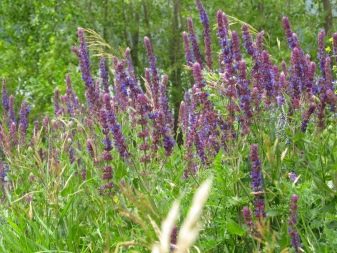
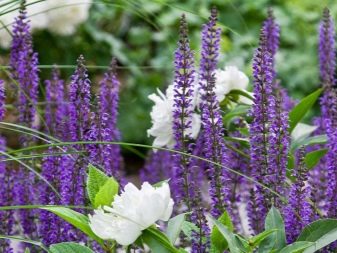
In its original homeland, salvia is a herbaceous perennial, a small shrub with a powerful root system, a spike-shaped, pyramidal inflorescence, the most variable color range. Inflorescences are not only different in shades - they are large. A significant part of the tubular stem can contain from 30 to 90 flowers, reach a length of 17 to 22 cm.Stunted and tall species have different growing periods, a common feature is abundant flowering, which starts in early summer and can continue until late autumn.

Salvia brilliant is found in the description as brilliant sage, but the most characteristic features are:
- constant demand for landscape design;
- perennial, which is forcedly grown as an annual in the harsh conditions of a temperate climate;
- many gorgeous colors, always luxurious appearance, although the traditional color is a blazing red;
- the possibility of growing outdoors, as a houseplant and decoration for balconies, terraces and verandas.

In addition to the popular variety with the romantic name "Scarlet" - a well-leafy, compact plant with bright red inflorescences, brilliant Salvia include:
- Zurich - also red, but with larger inflorescences;
- drought tolerant "Carabiner";
- "Bonfire" - blooming until the very late frosts;
- compact "Fire ball" - with red-coral pyramidal inflorescences, slightly disheveled;
- Vesuvius - fiery red, with more voluminous than others, leaf plates of a dark bottle color.





Features of medicinal sage
The medicinal plant (Latin name Salvia officinalis L) also belongs to the Lamiaceae family, but only a few colors are mentioned in the description - purple-lilac, pastel pink or white (less often) spike-shaped inflorescences. The flowers in them are smaller, arranged in rings, and the leaves are gray-green, finely toothed and do not differ in decorativeness.



Unlike the picturesque salvia, sage blooms only in late spring - early summer, and closer to the end of summer, you can collect nuts, widely used for useful purposes. Sage is grown on plantations or in the local area, but not for aesthetic purposes. It is a valuable medicinal and essential oil plant, presumably originating from Asia Minor., although the distribution in the wild was noted in the Caucasus, Crimea and Krasnodar Territory, the Mediterranean, the Balkan countries, southern Ukraine and Moldova. The main differences from salvia:
- chemical composition (essential oils, terpene compounds, including up to 15% cineole);
- pharmacological properties - astringent (due to tannins), anti-inflammatory and antimicrobial action, especially in relation to gram-positive strains;
- application of useful features in pharmaceuticals and traditional medicine, the cosmetic industry.

It is noted that they knew about the valuable properties of sage even in Ancient Greece, but they did not always use it in modern directions - they treated infertility, protected themselves from plague infection, prepared tea and recommended it to optimize the work of internal organs, especially with a diseased liver. Now the leaf infusion is sold in the pharmacy as a topical agent for the treatment of inflammatory diseases of the oral cavity.

Salvia red
Salvia coccinea is used exclusively for decorative purposes, as it blooms from late June to late autumn.... Florists give her special preference, and this is no coincidence. Any flower garden can be ennobled with its picturesque, fiery inflorescences visible from afar. In a warm climate, its cultivation is a more rewarding occupation, since there it winters calmly and grows like a perennial, renewing its activity every spring.

But even a one-year cycle implies gratitude for the care and agricultural technology - on each shoot of a low compact bush, a spike-shaped inflorescence blooms, on which there are several flowers of a dominant kumach shade, visible from afar and through the most abundant greenery.
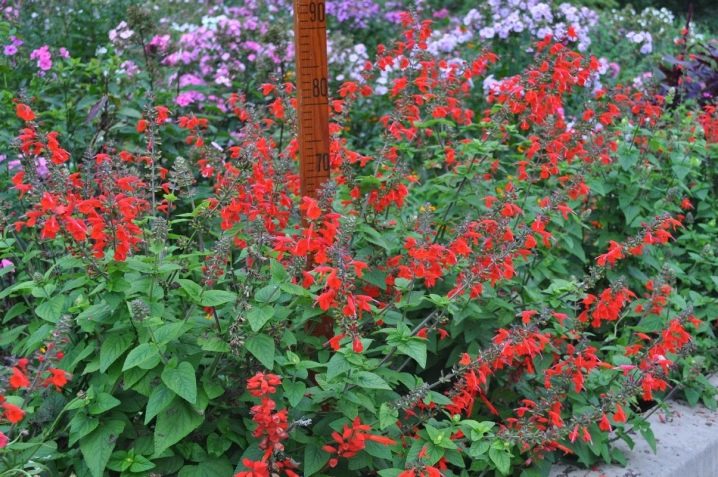
Other popular varieties and their varieties
Numerous publications mention varieties that are more often found among originators and agricultural firms in the assortment and therefore are declared as species in demand among flower growers:
- green, variegated or Horminum salvia, with pastel pink inflorescences, picturesquely shaded bracts in deep pink or purple tones;
- undersized (up to 40 cm), compact, whorled, on which the flowers are numerous, but small, of a pleasant violet-lilac shade;
- salvia reddy - dwarf, early flowering, with large flowers on a racemose inflorescence, blooming all summer, suitable for growing in pots, patios and containers;
- lyre, with purple foliage and small white flowers, especially picturesque in autumn, when the leaves change their color, perennial, beautiful in any company - with other perennials, boulders, ornamental shrubs.
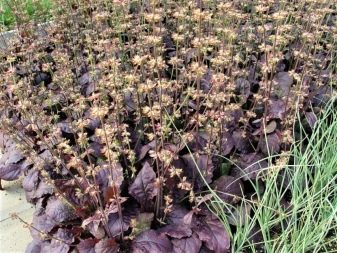
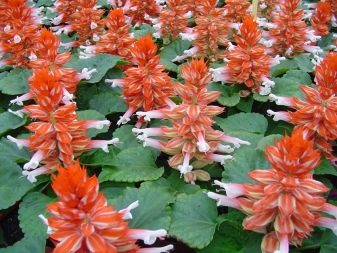


With a careful study, you can get acquainted with other species - dominant, tall and short, with different inflorescences, large and small flowers, fragrant, unpretentious in care, shading or spectacular. And all of them can be grown on their own land ownership or in a tiny front garden near the MKD, in a city flower bed, in a public garden or park.


Small-leaved
The second name, no less common, is "myrtle salvia", with large light green leaves, when rubbed, emitting a characteristic tart blackcurrant aroma. It begins to bloom in July. The range includes plants that bloom in scarlet, red-white or yellow flowers.

Variegated
Contrary to expectations, green or variegated salvia comes in a wide variety of flower shades. It grows about half a meter or a little more. Its distinctive feature is oval elliptical leaves. Dense and pubescent stems provide her with stability. They speak of belonging to a category that is weakly susceptible to the climatic conditions of the middle zone.
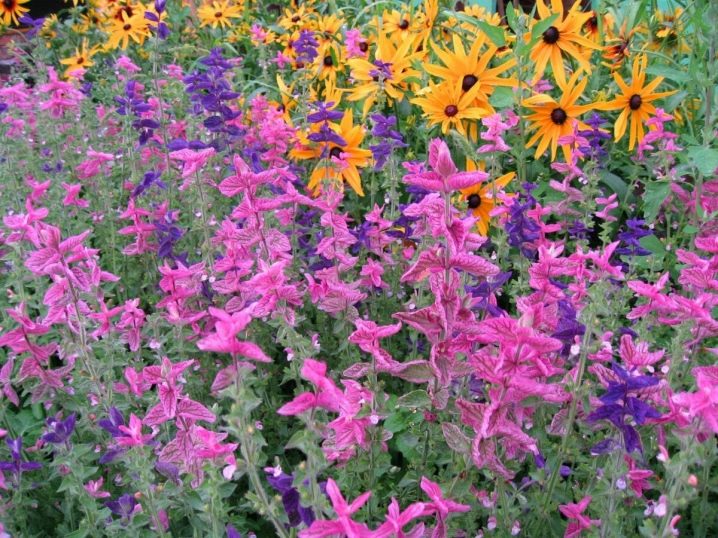
Floury
A tall, almost one meter high, pyramidal bush with long flowering and commendable ease of maintenance. Bright green leaves in the shape of an ellipse are presented in sufficient quantity so that small lilac inflorescences look spectacular against their background.

Whorled
Refers to the ornamental species of Salvia, endowed with breeders' resistance to cold climates. From mid-summer to late autumn, it pleases the eye of the owner of the site with bright purple flowers. Alba, which also belongs to the whorled, has dazzling white flowers.

Muscat
A unique, maintenance-free plant with a spicy, pleasant aroma that attracts insects for pollination. The leaves of the plant are used to make medicinal tea, medicinal decoctions and infusions, the pleasant smell raises your spirits and evokes positive emotions. This is a voluminous bush that can easily live in a flower bed for a decade.
The original inflorescences are perfectly combined with red and burgundy roses, rose hips or berries.

Dubravnaya
This cultivar is known as plumosa sage, a herbaceous shrub, annual or perennial... Varieties are especially popular "Lilac Glade", "Caradonna", with loose inflorescences of a violet-blue range and "Marcus", also blue-violet, up to 20 cm high. Rose Queen especially in demand due to its pleasant aroma and large pink inflorescences, sometimes with an indistinct lilac tint.

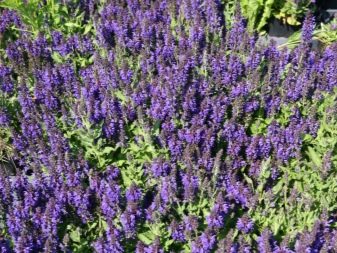
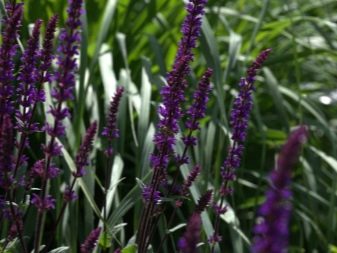

Meadow
More often found as meadow sage, grows in natural conditions, on slopes. The inflorescences are purple, the aroma is pronounced and specific. It has medicinal properties, but to a lesser extent than medicinal sage, however, in the essential oil, which is made from fresh leaves, there are many active components, it is used in the treatment of many diseases.

Divinorum
Better known as diviner sage because it contains a psychoactive hallucinogen. The plant is forbidden to grow because of its special effects. Those who like to travel to other realities used it in smoking or taking it to lose self-control and fall into a state of inadequacy.
Although it was previously used in smoking mixtures, it is now banned not only in Russia, but also in Europe and in some American states.

It is almost impossible to get cuttings or seeds for breeding.
Salvia - "protecting" or "saving" in a literal translation from Latin, does not have medicinal properties. No active plant compounds were found in the sparkling or glittering variety.
But its indescribably picturesque features and ease of cultivation is the main reason for its demand for 3 centuries, from the moment it entered Europe from Latin America.































































The comment was sent successfully.